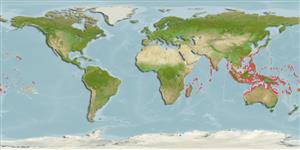Common names from other countries
>
Eupercaria/misc (Various families in series Eupercaria) >
Labridae (Wrasses) > Corinae
Etymology: Thalassoma: Greek, thalassa = the sea + Greek, soma = body; the colour of the sea (Ref. 45335).
Environment: milieu / climate zone / depth range / distribution range
Ecología
marino asociado a arrecife; no migratorio; rango de profundidad 0 - 15 m (Ref. 2334), usually 0 - 15 m (Ref. 27115). Tropical; 24°C - 28°C (Ref. 27115); 30°N - 32°S
Indo-Pacific: East Africa to the Line and Tuamoto islands, north to southern Japan, south to the Lord Howe and Austral islands.
Length at first maturity / Tamaño / Peso / Age
Maturity: Lm 8.5 range ? - ? cm
Max length : 25.0 cm TL macho / no sexado; (Ref. 129178); common length : 15.0 cm TL macho / no sexado; (Ref. 6113)
Espinas dorsales (total): 8; Radios blandos dorsales (total): 12-14; Espinas anales 3; Radios blandos anales: 11. Color pattern remains similar with growth with terminal males becoming gaudier than primary males (Ref. 37816). Pale green with 6 dark bars, last two as saddles over the tail. Head with pink bands radiating from eye in large adults (Ref. 48636).
Occurs in shallow lagoon and seaward reefs, slopes and along drop-offs to moderate depths. Occurs in small, loose groups (Ref. 48636). Feeds on benthic and planktonic crustaceans, small fishes, and foraminiferans.
Life cycle and mating behavior
Madurez | Reproducción | Puesta | Huevos | Fecundidad | Larva
Oviparous, distinct pairing during breeding (Ref. 205).
Randall, J.E., G.R. Allen and R.C. Steene, 1990. Fishes of the Great Barrier Reef and Coral Sea. University of Hawaii Press, Honolulu, Hawaii. 506 p. (Ref. 2334)
IUCN Red List Status (Ref. 130435)
CITES (Ref. 128078)
Not Evaluated
Threat to humans
Harmless
Human uses
Pesquerías: escaso valor comercial; Acuario: Comercial
Más información
ReferenciasAcuiculturaPerfil de acuiculturaRazasGenéticaElectrophoresesheritabilidadEnfermedadesProcesamientoMass conversion
Herramientas
Special reports
Download XML
Fuentes de Internet
Estimates based on models
Preferred temperature (Ref.
115969): 24.8 - 29.3, mean 28.4 (based on 2928 cells).
Phylogenetic diversity index (Ref.
82804): PD
50 = 0.5000 [Uniqueness, from 0.5 = low to 2.0 = high].
Bayesian length-weight: a=0.00955 (0.00610 - 0.01496), b=3.05 (2.92 - 3.18), in cm Total Length, based on LWR estimates for this species & Genus-body shape (Ref.
93245).
Nivel trófico (Ref.
69278): 3.5 ±0.37 se; based on food items.
Resiliencia (Ref.
120179): Alto, población duplicada en un tiempo mínimo inferior a 15 meses (K=1).
Fishing Vulnerability (Ref.
59153): Low vulnerability (16 of 100).
